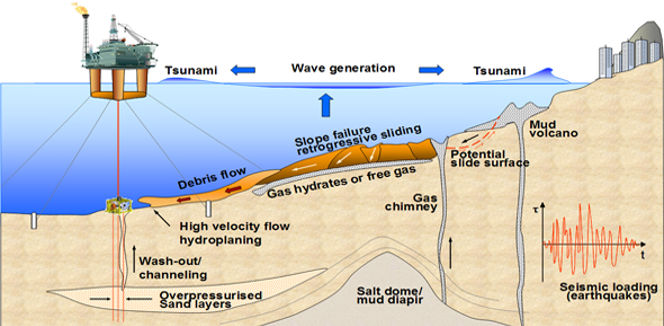- NGI /
- Projects /
- ICG - International Center for Geohazards /
- SP 6 - Offshore Geohazards
SP 6 - Offshore Geohazards
The focus on offshore geohazards has significantly increased over the last decade as the industry has moved into deeper areas.

Introduction
A geohazard is "A geological state, which represents or has the potential to develop further into a situation leading to damage or uncontrolled risk." Geohazards are found in all parts of the earth and are always related to geological conditions and geological processes, either recent or past.
Important offshore geohazards (Figure 1) include (i) slope instability and mass wasting processes (including debris flows and gravity flows); (ii) pore pressure phenomena (e.g., shallow gas accumulations, gas hydrates, shallow water flows, mud diapirism and mud volcanism, fluid vents, pockmarks); (iii) seismicity. Excess pore pressure development is a critical aspect in most offshore geohazards.

Figure 1: Schematic diagram showing main offshore geohazards
Submarine slope failure is the most severe threat on both local and regional scales. In addition to damaging offshore installations, slope failures may cause devastating tsunamis (see ICG-10). ICG personnel have long been involved in the studies of the Storegga Slide area offshore Mid-Norway. These studies were triggered by discovering Europe's third-largest gas reservoir Ormen Lange within the slide scar.
The Ormen Lange database includes seismic data, well logs, pore pressure data, geological data, and geotechnical test results, and as such, represents one of the most comprehensive multidisciplinary data sets on submarine landsliding from any continental margin. This work has led to several other slope stability R&D projects in recent years.
Pore pressure is a fundamental variable in the behavior of soil. Despite this, our ability to accurately measure, monitor and predict pore pressures in offshore sediments is limited and rarely done. Therefore, we must improve our understanding of excess pore pressure genesis (processes, migration), accurate measurement, and implications.
Further, it is hoped that tools can be developed to allow regional excess pore pressure fields to be mapped in detail, for example, through geophysical methods, geological interpretation, or observational or survey techniques. Once regional excess pore pressure fields are detected, sensors and instrumentation systems designed for short-term and long-term monitoring may make specific measurements.
Critical themes
In summary, the three critical themes of ICG SP 6 are:
- assessment of offshore geohazards in the upper tens to hundreds of meters below the seabed on high-latitude continental margins
- geophysical methods for offshore geohazards
- understanding and determining pore pressure in offshore sediments
Objectives
The overall scientific objectives within the Offshore Geohazards projects are:
- Multi-disciplinary approach: establish correlations between different data sets (i.e., geological, geotechnical, and geophysical) to improve the assessment and prediction of geohazards
- Geophysical methods and tools to extract geotechnical information and pore pressure (e.g., S-waves and surface waves)
- Gas and gas hydrates: increase our knowledge about their effects on slope instability
- Assess the implications of gravity flows on seabed infrastructure and prevention
Research Activities within ICG SP 6
- Assessing Offshore Geohazards: Site surveying and sampling of shallow, submarine landslides in coastal and deepwater environments
- Geophysical Methods and Modelling for Geohazards Characterization
- A Selection of Past Research Activities
Educational Components
ICG is a research and educational organization open to other international research institutes and facilities. At present, the following M.Sc., Ph.D., and post-doc researchers are affiliated with ICG SP 6:
- Nicole Baeten - Loslope project (Ph.D. student, Department of Geology, University of Tromsø, Norway)
- Eugene Morgan - Inversion of seismic data to determine pore pressure (Ph.D. student, Geohazards Engineering Research, Tufts University, Medford, USA)
- Guillaume Sauvin - Geophysics for Geohazards (Ph.D. student, NORSAR)
Publications and Presentations
See here for a list of selected theses, publications, and presentations.
Staff
ICG Scientists
(Alphabetic order)
- Shyam Chand, marine geophysics (NGU)
- Carl Fredrik Forsberg, marine geology (NGI)
- Tore Jan Kvalstad, geotechnics, technical expert (NGI)
- Isabelle Lecomte, geophysics (NORSAR)
- Jean-Sebastien L'Heureux, marine geology and geotechnics (NGU)
- Oddvar Longva, marine geology (NGU)
- Guillaume Sauvin, Geophysics (NORSAR)
- Anders Solheim, marine geology (NGI)
- James M. Strout, geotechnics, instruments, pore pressures (NGI)
- Maarten Vanneste, P.I., marine
Affiliated Scientists/Institutes
- Eugene Morgan, Tufts University, Medford, USA
- Mark E. Vardy, National Oceanography Centre Southampton, UK
- Ulrich Polom, LIAG, Hannover, Germany
- Achim Kopf, MARUM University of Bremen, Germany
- Jan Sverre Laberg, University of Tromsø, Norway
- Nicole Baeten, University of Tromsø, Norway
- Haflidi Haflidason, University of Bergen, Norway
- Berit O. Hjelstuen, University of Bergen, Norway
- Valentina L. Socco, Polytecnico di Torino, Italy
- Arash Zakeri, C-Core, Canada
